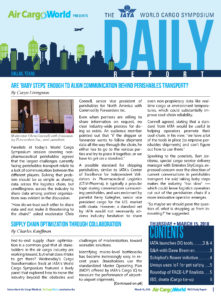No products in the cart.
WCS 2018: Supply chain optimization through collaboration
 DALLAS – End-to-end supply chain optimization is a common goal that all stakeholders in the air cargo industry are working toward, but what does it take to get there? Wednesday’s Cargo Transformation Track at IATA’s World Cargo Symposium featured a lively panel that explored how to move the industry beyond the obstacles and challenges of modernization, toward workable solutions.
DALLAS – End-to-end supply chain optimization is a common goal that all stakeholders in the air cargo industry are working toward, but what does it take to get there? Wednesday’s Cargo Transformation Track at IATA’s World Cargo Symposium featured a lively panel that explored how to move the industry beyond the obstacles and challenges of modernization, toward workable solutions.
Identifying macro-level bottlenecks has become increasingly easy in recent years. Stakeholders use the standardized Master Operating Plan (MOP) offered by IATA’s Cargo iQ to measure the performance of airport-to-airport shipments. The time it takes to clear customs is one such process that varies greatly, with a global average of 1.41 days, said Laura Rodriguez, assistant manager for Cargo iQ.
Shaving time off that figure will involve overcoming the fragmented connections between stakeholders. “We’re tackling issues based on needs in the little silos we have. This is what we need to get away from and is why I think we need to be more conscious about involving customs, security, all of those things that aren’t embedded in the full-view end-to-end,” said Matthias Hurst, director of global airfreight initiatives for Agility.
Panelists agreed that the second act of air cargo’s modernization playbook will be data-driven, but there was debate as to whether new standards will be necessary to ensure that disjointed IT systems can interface.
Hurst pointed out a concern that small and medium-sized freight forwarders might fall behind without a standard for data exchanges.
Sara Van Gelder, the cargo and logistics development manager for Brussels Airport, sees this concern as an argument for localized, community-based action. “We need to create small environments where stakeholders see the added-value immediately,” she said. “The data elements and how to exchange will follow. I’m sure that by the time all of the communities are completely digitalized and paperless, there will be a language.”
















